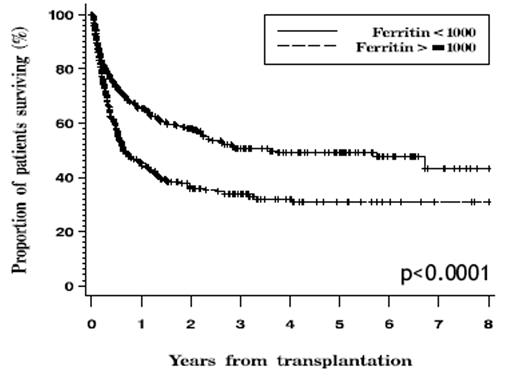Abstract
Patients undergoing allogeneic stem cell transplantation (alloSCT) for hematologic malignancies are often highly transfused, and thus at risk for transfusion-associated iron overload. In other settings, such as thalassemia or hemochromatosis, iron overload has been associated with organ toxicity, particularly hepatotoxicity, as well as with an increased susceptibility to infection. Since hepatic and infectious complications are frequent and life-threatening in patients undergoing alloSCT, iron overload could potentially be an important contributor to treatment-related morbidity and mortality after transplantation. We studied 935 consecutive patients who underwent myeloablative alloSCT at our institution between 1997 and 2005. A pre-transplant serum ferritin level, which we used as a surrogate measure of iron load, was available for 600 of the 935 patients (64%). The median ferritin level was 864ng/ml. The percentage of patients with serum ferritin ≥1000ng/ml was 47%. This percentage varied significantly between disease types, being lowest (6%) in patients with CML and highest (79%) in patients with AML. A ferritin level ≥1000ng/ml was associated with significantly worse overall and disease-free survival, as shown in the figure.
This was confirmed in proportional hazards models using the following covariates: age, type and stage of disease, cytogenetic risk group for AML and MDS, conditioning regimen, HLA match, graft source, GVHD prophylaxis regimen, CMV serostatus, gender, prior transplant, and year of transplantation. In this model, the hazard ratio for mortality associated with ferritin ≥1000ng/ml was 1.7 (95%CI=1.3 to 2.4, p=0.0005). In competing risks regression analysis, using the same covariates, an elevated serum ferritin was associated with a significant increase in non-relapse mortality (NRM) (HR=1.6, p=0.02), but not with a significant increase in the risk of relapse. The greatest impact of elevated serum ferritin on survival and NRM was in patients with MDS (HR for mortality=3.0, p=0.001). Because serum ferritin is an acute phase reactant, we performed the same analyses using pre-transplant albumin level as an additional covariate that could reflect general inflammatory state. Although albumin level was of independent prognostic significance, its inclusion in the multivariate models did not alter the conclusions. Finally, in logistic regression analyses, elevated serum ferritin was associated with a non-significant increase in the risk of veno-occlusive disease (OR=1.6, p=0.09), but not in an increased risk of acute GVHD (OR=0.9, p=0.4) or specifically of acute liver GVHD (OR=1.2, p=0.5).
Conclusions: in patients undergoing myeloablative alloSCT, and particularly in those with MDS, an elevated serum ferritin is associated with significantly higher NRM, as well as significantly lower disease-free and overall-survival. Our results could be helpful in estimating prognosis for patients who are candidates for myeloablative alloSCT. They also pave the way for prospective trials on the impact of iron overload and on the possible beneficial role of iron chelation in this patient population.
Disclosure: No relevant conflicts of interest to declare.
Author notes
Corresponding author


